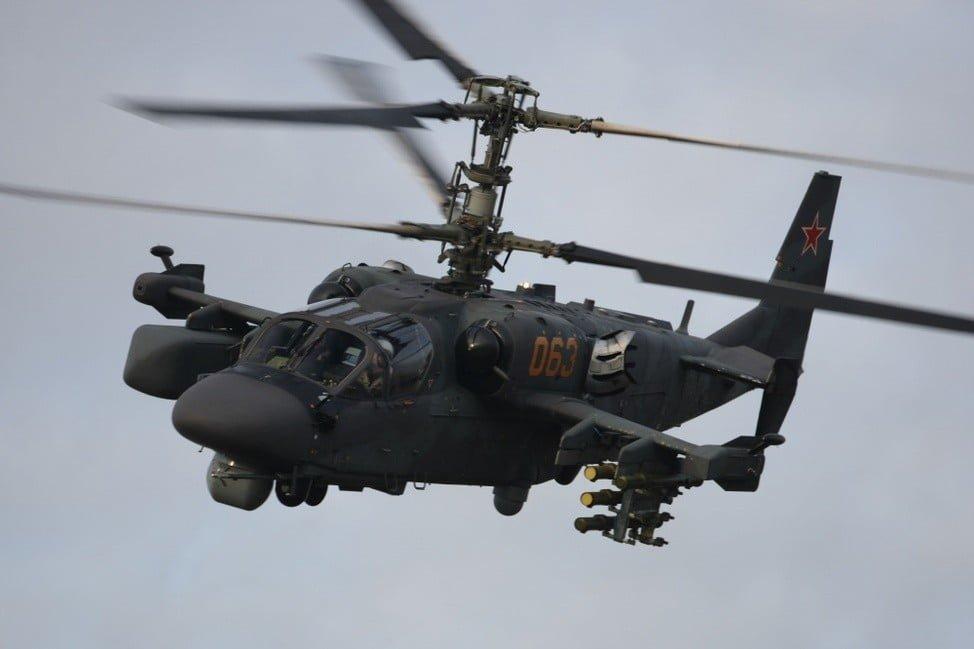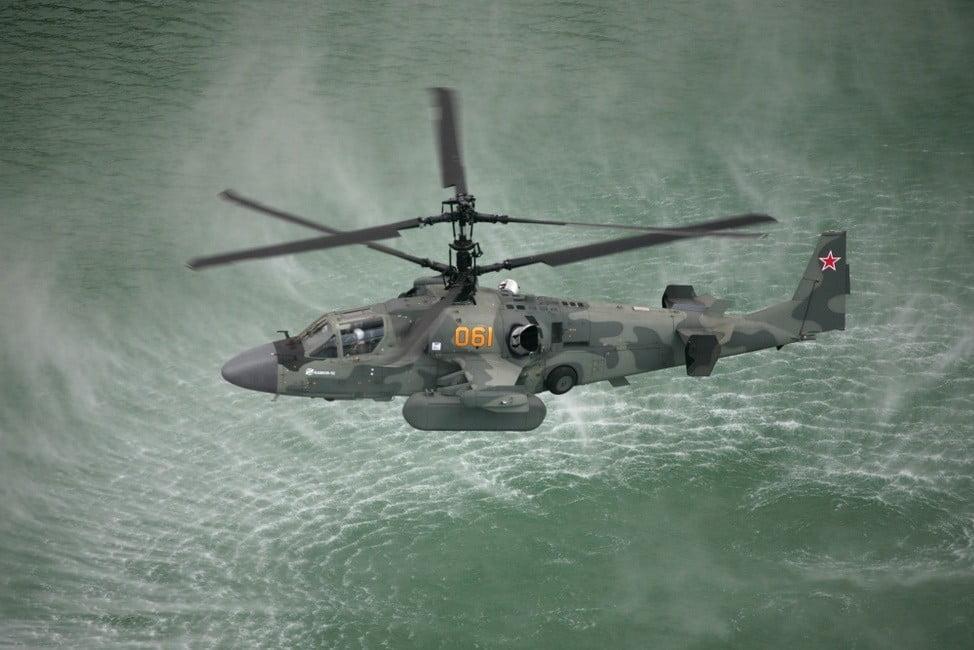The new state-of-art Russian combat helicopter designed as Kamov Ka-52 Alligator is a next-generation reconnaissance and combat helicopter, now battle-proven and combat-ready. It is primarily designed to destroy tanks, armored and non-armored ground targets, enemy troops, and helicopters on the front line and in tactical reserves. It is designed to withstand and operate in all weather and climate conditions.
Introduction
The Kamov Design Bureau developed this Russian attack helicopter as a derivative of the Kamov Ka-50 “Black Shark,” which was developed in the 1980s. The Ka-52 Alligator was designed to be a more advanced and capable version of the Ka-50, with improved avionics, weapons systems, and other features.
The helicopter can operate around the clock and in all weather. It can provide target acquisition and designation for helicopter teams and ground troop command and control centers. It can also provide fire support for troop landings, fly routine patrols and escort military convoys.
While the Mi-28 family of helicopters has become the “protector” of the army, specifically serving in the operations of the Russian ground forces, the Kamov Ka-52 has, in a way, become a symbol of the Russian special forces, as it provides them with air support during operations. What distinguishes the Ka-52 from its competition, both aesthetically and in terms of performance, are its counter-rotating propellers.
History and development
In the early 1980s, while comparative tests of the V-80 (Ka-50 prototype) and the Mi-28 were being conducted, the Kamov design team came up with a proposal to develop a dedicated combat helicopter to perform battlefield reconnaissance, provide target designation, support, and co-ordinate group attack helicopter operations. However, the economic hardships that hit the nation in the late 1980s hampered this new development program.
This prompted Kamov’s Designer General to choose a modified version of the Kamov Ka-50 to install the reconnaissance and target designation system. The modified “Black Shark” required a second crew member to operate the optronics/radar reconnaissance suite. Kamov decided to use a side-by-side seating arrangement due to the verified improvements in cooperation between the crew members. This twin-seat version was designated Kamov Ka-52.
The development of the Ka-52 Alligator began in the 1990s, unveiling the prototype in mid-1996. Series production was started in the autumn of 2008. The helicopter underwent extensive testing and development before being put into production. It was officially unveiled at the Moscow International Aviation and Space Salon in 1999.
The Kamov Ka-52 Alligator can perform feats that other helicopters in its class cannot even imagine, such as flying with its tail forward or hovering around a single aiming point with its weapons constantly aimed in the nose of the fuselage. This level of flight performance is made possible by the unique design of the “Alligator.” Additionally, the helicopter is built on a coaxial scheme, which gives it greater maneuverability, safety, and ease of control.
Kamov Design Bureau
The 696th Instructor and Research Helicopter Regiment, based at Torzhok Air Base, operates eight helicopters, in varying degrees of capability and modification, for research and development. In December 2010, four new, series-production Kamov Ka-52s were delivered to the 344th Centre for Combat Training and Aircrew Conversion Air Base.
Design and armament
The combat helicopter Kamov Ka-52 Alligator is fitted with signature control devices and electronic and active counter-measures. It meets the latest Russian and international standards for the technical operation of military combat helicopters.

The helicopter has a two-seat cockpit and can be flown by either pilot. Thanks to its coaxial rotors, its advanced flight capabilities make the helicopter highly maneuverable in limited space and thus adopt an advantageous attack position.
The Kamov Ka-52 Alligator’s two VK-2500 turboshaft engines allow the helicopter to operate at altitudes above 5,000m. It has a static ceiling of 4,000 m and can take off and land in hot climates and high mountainous terrain. The Alligator can also operate in cold climates and icy conditions.
It is also equipped with the latest avionics suite and powerful offensive weapons that can be configured for a wide range of combat missions. The Kamov Ka-52 Alligator offers a high degree of protection to its crew, advanced automated systems for ease of piloting, and is easy to service and maintain on the ground. Some of the weapons and equipment carried by the Ka-52 Alligator include:
Missiles
An integral part of the armament of the Kamov Ka-52 helicopter is the “Vihr-M” guided weapon system. This helicopter can carry up to 12 supersonic, laser-guided 9M127-1 “Vihr-1” missiles designed to engage modern tanks. These weapons allow the helicopter to engage various targets, including ground vehicles, aircraft, and buildings.
Bombs
The Ka-52 Alligator can carry a range of bombs, including high-explosive and incendiary bombs. These weapons destroy buildings, fortifications, and other targets on the ground.
Cannon
The Ka-52 Alligator has a 30 mm automatic cannon mounted on the helicopter’s underside. The cannon engages targets on the ground or in the air and ranges around 2,000 meters (2,187 yards) with 200 to 800 rounds per minute.
Avionics and sensor systems
The Ka-52 Alligator has various advanced avionics and sensor systems, including radar, a thermal imaging camera, and a laser rangefinder. These systems give the helicopter a high level of situational awareness and the ability to operate in various environments.
Other equipment
In addition to its weapons and sensors, the Ka-52 Alligator is equipped with other equipment, such as flares and chaff to counter enemy missiles and a self-defense suite to protect against enemy fire. It also has a rescue hoist and other equipment to support search and rescue missions.
Operational history
The Russian military has used the Ka-52 Alligator in several operations, including the conflicts in Chechnya, Syria, and now these days in Ukraine. It has also been exported to other countries, including Algeria, Egypt, and Vietnam.
Syrian Civil War
Ka-52 helicopters were spotted being deployed in support of the Russian military intervention in the Syrian Civil War in 2015, various sources stating they were involved in defense of the Russian base in Latakia, providing escort for search and rescue helicopters, and supporting Russian special forces.
For the first time, Kamov Ka-52s were seen near the town of Al-Qaryatayn, recaptured in early April 2016 from ISIS. They took part in the 2017 Palmyra offensive. On August 12, 2017, they took part in a Syrian paratroopers operation conducting a reconnaissance-strike mission. According to some sources, on May 5, 2018, a Ka-52 crashed near Mayadin due to a technical failure.
Ukraine War
On February 24, 2022, during the initial stages of the Russian invasion of Ukraine, at least one Russian Ka-52 helicopter was damaged and crash-landed. On March 2, a Russian Ka-52 was hit by a surface-to-air missile and crash-landed. On March 12, Ukrainian forces reported that the troops had shot down Ka-52 RF 13409 in Novomykolaivka near Kherson.
Technical specifications:
Flight capabilities | |
|---|---|
|
Static ceiling:
|
Up to 4,000m
|
|
Operational ceiling:
|
5,500m
|
|
Engines:
|
2 x VK-2500 or VK-2500P
|
|
Take-off power:
|
2 x 2,400hp
|
|
Maximum acceleration at sea level:
|
16m/s
|
|
Vertical acceleration at sea level:
|
12m/s
|
|
Maximum speed:
|
300km/h
|
|
Cruising speed:
|
260km/h
|
|
Ferry range
|
1,100km
|
|
Practical range (internal fuel tanks)
|
460km
|
Main armaments | |
| The Kamov Ka-52 Alligator is equipped with a 30mm caliber 2A42-1 aircraft gun and can also carry a Strelets missile system, launch systems for guided missiles such as Ataka and V-1, and a launch system for S-8 unguided missiles. | |
Emergency systems | |
| K-37-800M shock-absorbing ejector seats |

